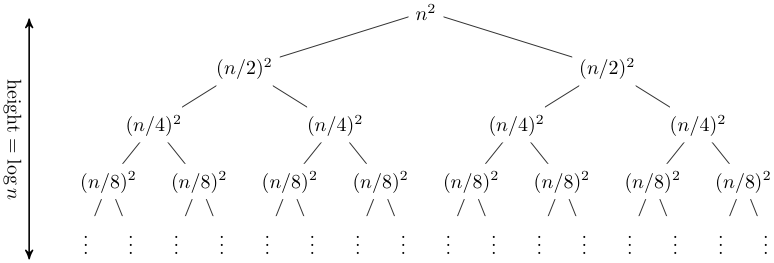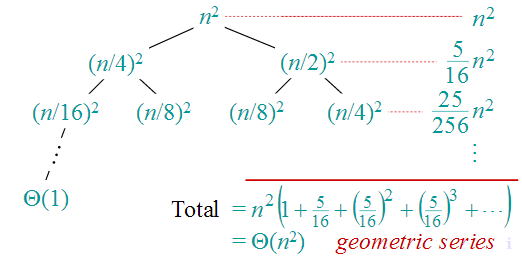Divide-and-Conquer
In divide-and-conquer, we solve a problem recursively, applying three steps at each level of the recursion:
Divide the problem into a number of sub-problems that are smaller instances of the same problem.
Conquer the sub-problems by solving them recursively. If the sub-problem sizes are small enough, however, just solve the sub-problems in a straightforward manner.
Combine the solutions to the sub-problems into the solution for the original problem.
When the sub-problems are large enough to solve recursively, we call that the recursive case. Once the sub-problems become small enough that we no longer recurse, we say that the recursion “bottoms out” and that we have gotten down to the base case.
Recurrences can take many forms. For example, a recursive algorithm might divide sub-problems into unequal sizes, such as a 2/3 to 1/3 split. If the divide and combine steps take linear time, such an algorithm would give rise to the recurrence
T(n) = T(2n/3) + T(n/3) + Θ(n)
Maximum Subarray Problem
Aim: To find the maximum subarray of the Array
Suppose we want to find a maximum subarray of the subarray A[low...high]. Divide-and-conquer suggests that we divide the subarray into two subarrays of as equal size as possible. That is, we find the midpoint, say mid, of the subarray, and consider the subarrays A[low..mid] and A[mid+1....high].
Any contiguous subarray A[i...j] of A[low...high] must lie in exactly one of the following places:
Entirely in the subarray A[low..mid],so that low ≤ i ≤ j ≤ mid
entirely in the subarray A[mid + 1...high],so that mid < i ≤ j ≤ high,or
crossing the midpoint, so that low ≤ i ≤ mid < j ≤ high.
Therefore, a maximum subarray of A[low...high] must lie in exactly one of these places. In fact, a maximum subarray of A[low...high] must have the greatest sum over all subarrays entirely in A[low...mid], entirely in A[mid + 1..high], or crossing the midpoint. We can find maximum subarrays of A[low...mid] and A[mid+1...high] recursively, because these two subproblems are smaller instances of the problem of finding a maximum subarray.
Any subarray crossing the midpoint is itself made of two subarrays A[i...mid] and A[mid + 1...j],where low ≤ i ≤ mid and mid < j ≤ high. Therefore, we just need to find maximum subarrays of the form A[i...mid] and A[mid+1..j] and then combine them.
Maximum Subarray Algorithm
FIND-MAX-CROSSING-SUBARRAY(A, low, mid, high)
left-sum = -∞
sum = 0
for i = mid downto low
sum = sum + A[i]
if sum > left-sum
left-sum = sum
max-left = i
right-sum = -∞
sum = 0
for j = mid + 1 to high
sum = sum + A[j]
if sum > right-sum
right-sum = sum
max-right = j
return (max-left, max-right, left-sum + right-sum)
Maximum Subarray Algorithm - Divide and Conquer
FIND-MAXIMUM-SUBARRAY(A, low, high)
if high == low
return (low, high,A[low]) // base case: only one element
else mid = (low + high)/2
(left-low,left-high, left-sum) = FIND-MAXIMUM-SUBARRAY(A, low, mid)
(right-low, right-high, right-sum) = FIND-MAXIMUM-SUBARRAY(A, mid+1, high)
(cross-low, cross-high, cross-sum) = FIND-MAX-CROSSING-SUBARRAY(A, low, mid, high)
if left-sum > right-sum and left-sum > cross-sum
return (left-low, left-high, left-sum)
elseif right-sum > left-sum and right-sum > cross-sum
return (right-low, right-high, right-sum)
else return (cross-low, cross-high, cross-sum)
Q. What does FIND-MAXIMUM-SUBARRAY return when all elements of A are negative?
It will return the least negative position. As each of the cross sums are computed, the most positive one must have the shorest possible lengths.
The algoritm doesn't consider length zero sub arrays, so it must have length 1.
Q. Write pseudocode for the brute-force method of solving the maximum-subarray problem. Your procedure should run in Θ(n2) time.
Algorithm 1: Brute Force Algorithm to Solve Maximum Subarray Problem
left = 1
right = 1
max = A[1]
curSum = 0
for i = 1 to n do // Increment left end of subarray
curSum = 0
for j = i to n do // Increment right end of subarray
curSum = curSum + A[j]
if curSum > max then
max = curSum
left = i
right = j
end if
end for
end for
Q. Develop a nonrecursive, linear-time algorithm for the maximum-subarray problem.
Algorithm 2: linear time maximum subarray(A)
M = - ∞
low_M, high_M = null
M_r = 0
low_r = 1
for i from 1 to A.length do
M_r + = A[i]
if M_r > M then
low_M = low_r
high_M = i
M = M_r
end if
if M_r < 0 then
M_r = 0
low_r = i + 1
end if
return ( low_M, high_M, M )
end for
Algorithm for matrix multiplication
If A = (aij) and B = (bij) are square n * n matrices, then in the product C = A . B,we define the entry (cij) for i, j = 1, 2 , ... , n by
\( c_{ij} = \sum_{k = 1}^{n} a_{ik} . b_{kj} \)
We must compute n2 matrix entries, and each is the sum of n values. The following procedure takes n * n matrices A and B and multiplies them, returning their n * n product C. We assume that each matrix has an attribute rows, giving the number of rows in the matrix.
SQUARE-MATRIX-MULTIPLY(A,B)
n = A.rows
let C be a new n*n matrix
for i = 1 to n
for j = 1 to n
cij = 0
for k = 1 to n
cij = cij + (aik * bkj)
return C
Time Complexity:Because each of the triply-nested for loops runs exactly 'n' iterations, and each execution of line 9 takes constant time, the SQUARE-MATRIX-MULTIPLY procedure takes Θ(n3) time.
Strassen’s Algorithm for matrix multiplication
To compute the matrix product C = A * B, we assume that n is an exact power of 2 in each of the n * n matrices.
Algorithm 3: Strassen(A, B)
if A.length == 1 then
return A[1] . B[1]
end if
Let C be a new n by n matrix
A11 = A[1..n/2][1..n/2]
A12 = A[1...n/2][n/2 + 1...n]
A21 = A[n/2 + 1...n][1...n/2]
A22 = A[n/2 + 1...n][n/2 + 1...n]
B11 = B[1...n/2][1...n/2]
B12 = B[1...n/2][n/2 + 1...n]
B21 = B[n/2 + 1...n][1...n/2]
B22 = B[n/2 + 1...n][n/2 + 1...n]
S1= B12 + B22
S2= A11 + A12
S3= A21 + A22
S4= B21 - B11
S5= A11 + A22
S6= B11 + B22
S7= A12 - A22
S8= B21 + B22
S9= A11 - A21
S10= B11 + B12
P1 = Strassen(A11; S1)
P2 = Strassen(S2, B22)
P3 = Strassen(S3, B11)
P4 = Strassen(A22, S4)
P5 = Strassen(S5, S6)
P6 = Strassen(S7, S8)
P7 = Strassen(S9, S10)
C[1...n/2][1...n/2] = P5 + P4 - P2 + P6
C[1...n/2][n/2 + 1...n] = P1 + P2
C[n/2 + 1...n][1...n/2] = P3 + P4
C[n/2 + 1...n][n/2 + 1...n] = P5 + P1 - P3 - P7
return C
Time Complexity:Θ(n2.81) time.
Solving Recurrance relation - Iteration method
Let's use the iterative method to figure out the running time of merge_sort. We know that for Merge sort
T(1) = 1
T(n) = 2 T(n/2) + n
Starting with the iterative method, we can start expanding the time equation until we notice a pattern:
Solution:
T(n) = n + T(n/2)
= n + n + T(n/4)
= n + n + n + T(n/8)
= n + n + n + n + T(n/24)
After 'k' iterations
T(n) = n + n + n + n + n + ... + T(n/2k)
Assume n=2k then k = lg n and
T(n) = k * n + T(1)
T(n) = n lg n
Q. Solve the recurrence using iteration method: T(n) = c + T(n/2)
T(n) = c + T(n/2)
= c + c + T(n/4)
= c + c + c + T(n/8)
= c + c + c + c + T(n/24)
After 'k' iterations
T(n) = c + c + c + c + c + ... + T(n/2k)
Assume n=2k then k = lg n and
T(n) = k * c + T(1)
T(n) = c lg n
Q. Solve the recurrance using iteration method: T(n) = n + 2T(n/2)
T(n) = n + 2T(n/2)
= n + 2(n/2 + 2T(n/4))
= n + n + 4T(n/4)
= n + n + 4(n/4 + 2T(n/8))
= n + n + n + 8T(n/8)
T(n) = 3n + 23T(n/23)
After 'k' iterations it is now:
T(n) = 3n + 2kT(n/2k)
Assume n=2k, k = lg n
= n lg n+ n T(1)
T(n) = O(nlgn)
Solving Recurrance relation - Recurrance Tree method
A recursion tree is useful for visualizing what happens when a recurrence is iterated. It diagrams the tree of recursive calls and the amount of work done at each call. For E.g:, Recurrence is T(n) = 2T(n/2) + n2. The recursion tree for this recurrence has the following form:
Sum across each row of the tree to obtain the total work done at a given level
This a geometric series, thus in the limit the sum is O(n2)


Q. T(n) = T(n/4) + T(n/2) + n2

Master's Theorem: Solving Recurrence
“Cookbook” for solving recurrences of the form:
\( T(n) = aT(\frac{n}{b}) + f(n) \)
Where, a ≥ 1; b > 1 and f(n) > 0
Then, depending on the comparison between f(n), \( n^{{log}_b^a} \) there are three cases:
f(n) is asymptotically smaller or larger than \( n^{{log}_b^a} \) by a polynomial factor \( n^{\varepsilon} \)
f(n) is asymptotically equal with \( n^{{log}_b^a} \)
Case 1: f(n) = \( n^{{log}_b^a - \epsilon} \) for some ε > 0 then T(n) = Θ( \( n^{{log}_b^a}) \)
Case 2: f(n) = Θ( \( n^{{log}_b^a}) \) then T(n) = Θ( \( n^{{log}_b^a}) lg n\)
Case 3: f(n) = Ω( \( n^{{log}_b^a + \epsilon} \) ) for some ε > 0 then, and if af(n/b) ≤ cf(n) for some c < 1 and all sufficiently large n, then: T(n) = Θ(f(n))
Q. The time complexity of computing the transitive closure of a binary relation on a set of n elements is known to be (GATE 2005)
O (n)
O (n log n)
O(n3⁄2)
O(n3)
Ans . (a)
In mathematics, the transitive closure of a binary relation R on a set X is the smallest transitive relation on X that contains R. If the original relation is transitive, the transitive closure will be that same relation; otherwise, the transitive closure will be a different relation.
Q. The recurrence relation capturing the optimal execution time of the Towers of Hanoi problem with n discs is(GATE 2012)
T(n)=2T(n-2)+2
T(n)=2T(n-1)+n
T(n)=2T(n/2)+1
T(n)=2T(n-2)+1
Ans . 4
Let the three pegs be A,B and C respectively. Our goal is to move 'n' pegs from A to C with the help of peg B. The steps to do this are as follows:
move n−1 discs from A to B. This leaves \(n^{th}\) disc alone on peg A --- T(n-1)
move \(n^{th}\) disc from A to C --- 1
move n−1 discs from B to C so they sit on \(n^{th}\) disc --- T(n-1)
By adding the above we get
T(n) = T(n-1) + T(n-1) + 1
i.e T(n)=2T(n-2)+1